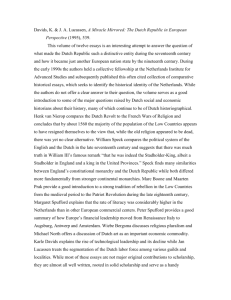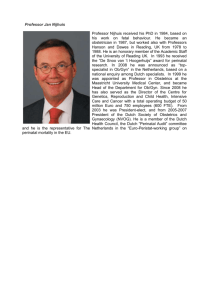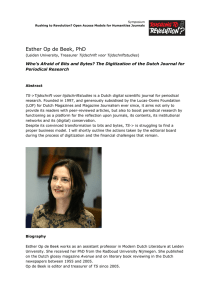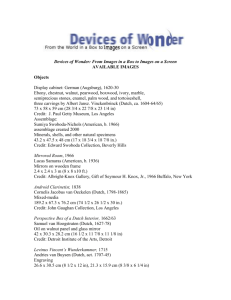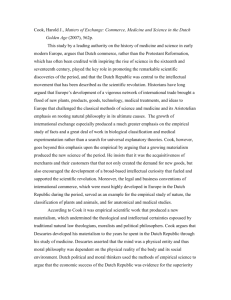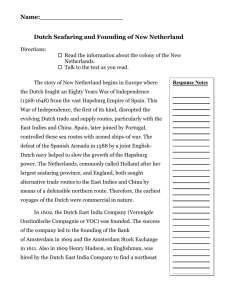Eastview High School AP European History Dutch Republic DBQ
advertisement
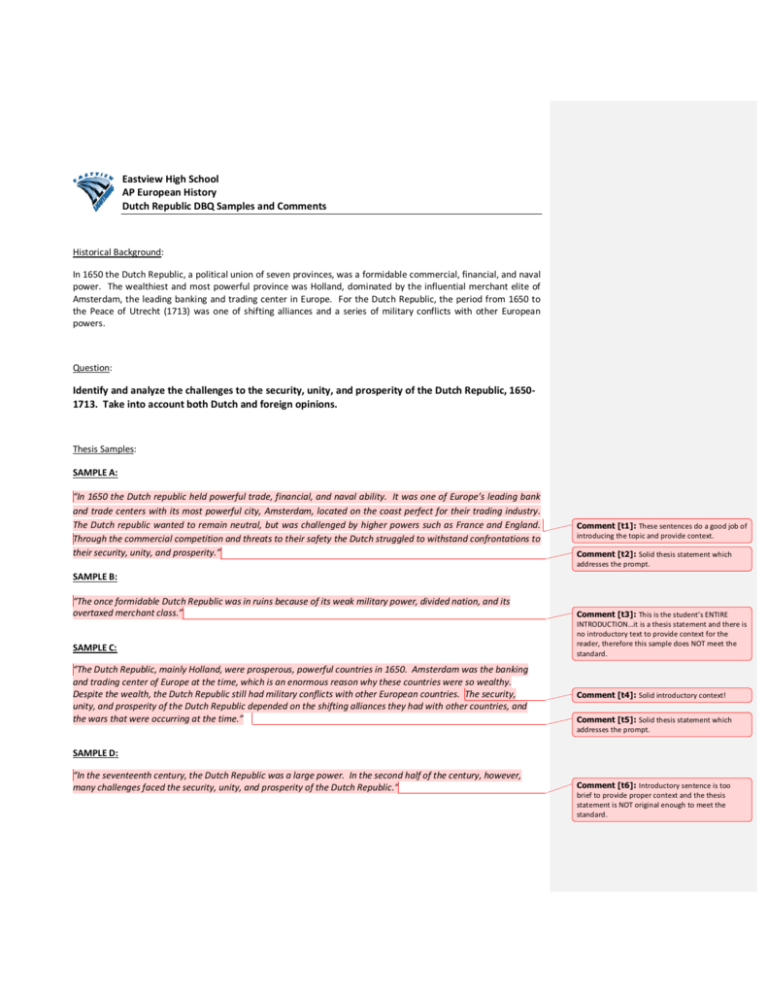
Eastview High School AP European History Dutch Republic DBQ Samples and Comments Historical Background: In 1650 the Dutch Republic, a political union of seven provinces, was a formidable commercial, financial, and naval power. The wealthiest and most powerful province was Holland, dominated by the influential merchant elite of Amsterdam, the leading banking and trading center in Europe. For the Dutch Republic, the period from 1650 to the Peace of Utrecht (1713) was one of shifting alliances and a series of military conflicts with other European powers. Question: Identify and analyze the challenges to the security, unity, and prosperity of the Dutch Republic, 16501713. Take into account both Dutch and foreign opinions. Thesis Samples: SAMPLE A: “In 1650 the Dutch republic held powerful trade, financial, and naval ability. It was one of Europe’s leading bank and trade centers with its most powerful city, Amsterdam, located on the coast perfect for their trading industry. The Dutch republic wanted to remain neutral, but was challenged by higher powers such as France and England. Through the commercial competition and threats to their safety the Dutch struggled to withstand confrontations to their security, unity, and prosperity.” Comment [t1]: These sentences do a good job of introducing the topic and provide context. Comment [t2]: Solid thesis statement which addresses the prompt. SAMPLE B: “The once formidable Dutch Republic was in ruins because of its weak military power, divided nation, and its overtaxed merchant class.” SAMPLE C: “The Dutch Republic, mainly Holland, were prosperous, powerful countries in 1650. Amsterdam was the banking and trading center of Europe at the time, which is an enormous reason why these countries were so wealthy. Despite the wealth, the Dutch Republic still had military conflicts with other European countries. The security, unity, and prosperity of the Dutch Republic depended on the shifting alliances they had with other countries, and the wars that were occurring at the time.” Comment [t3]: This is the student’s ENTIRE INTRODUCTION…it is a thesis statement and there is no introductory text to provide context for the reader, therefore this sample does NOT meet the standard. Comment [t4]: Solid introductory context! Comment [t5]: Solid thesis statement which addresses the prompt. SAMPLE D: “In the seventeenth century, the Dutch Republic was a large power. In the second half of the century, however, many challenges faced the security, unity, and prosperity of the Dutch Republic.” Comment [t6]: Introductory sentence is too brief to provide proper context and the thesis statement is NOT original enough to meet the standard. SAMPLE E: “Up until the year 1650, the Dutch Republic was a powerhouse of trade and banking, as well as a powerful naval force. However, from 1650 onward, things only got worse for this European power. Foreign threats and competition started to wither away the security, unity, and prosperity of this nation, slowly removing it from the status of global power.” Comment [t7]: Good work with introductory context and original thesis! POV Samples: SAMPLE F: “Marquis de Pomponne writes in his letter to the French government that the English East India Company is scaring the Dutch (Doc. 11). Since Marquis de Pomponne is a French ambassador, he is going to support the French cause and report information that proves joining with the English is keeping the Dutch from prospering greatly, since there is trade competition.” SAMPLE G: “Downing is saying in his letter to the English government that a war against the Dutch would be a good idea because of the division there. Downing holds these biased views because he wants England to prosper and take advantage of the Dutch when they are divided.” SAMPLE H: “In fact, England even encouraged aggression by France toward the Dutch to ruin their commerce which can be seen in a letter from the Dutch ambassador to England. Because the man is an ambassador to England, he is quick to say that the Dutch will fall, thus showing that England knows the Dutch are weak (Doc. 8).” SAMPLE I: “Besides France trying to destroy Dutch trade, the English were still determined to wage war on them. Konrad Van Beuningen stated this assumption in his letter to the Dutch republic. His point of view is considered credible since he is a Dutch ambassador to England.” SAMPLE J: “In a graph of the Baltic Sea trade from 1645-1695, the voyages of Dutch ships decline steadily (Doc 2). Declining voyages is a challenge to prosperity because if there are less voyages, less trade can be done and the prosperity or wealth of the Dutch Republic declines. This graph is objective as it only states the facts, nothing else.” SAMPLE K: “A political pamphlet in Amsterdam in 1683 questions who will pay for war when only Amsterdam is rich and everyone else is poor (doc. 10)? This upset statement by the author is a challenge to unity as debates could break the provinces apart as questions of finances arise. Being upset does not bring people together. This is also the opinion of a person from the Dutch Republic who would know the situation first-hand.” Comment [t8]: This sentence has SOME elements of proper ATTRIBUTION, ending with the document number in parenthesis. To improve, the writer should include more information about the source of the document such as when the letter was written. Comment [t9]: Good work here with POV…the writer points out that as “a French Ambassador” WHY he takes the position that he does. Comment [t10]: This POV sample meets the standard but just barely…there is NO attribution and the sentence structure is very rough. Comment [t11]: This sample is difficult to assess…the student identifies the “man is an ambassador to England…” but the analysis (because) is confused. Also to improve, the student MUST provide proper attribution. Comment [t12]: This sample does NOT meet the standard…the writer has IDENTIFIED POV but has NOT ANALYZED the POV. Comment [t13]: A better word here is “fewer” Comment [t14]: This is an adequate attempt to provide POV to a statistical document. The description of the document is well done. To improve this analysis the writer could suggest additional information which isn’t provided in the document but which may give a more accurate picture of the situation. Comment [t15]: While this sample is written a bit awkwardly, the writer does a nice job of identifying the TONE of the document (“upset statement”). What does a ‘9’ look like? Prior to 1650, the Dutch Republic was, in short, the “it” nation in Europe; with diverse cities which were quite th th modern by 16 and 17 century standards, bustling markets, and a city, Amsterdam, which was the leading banking center in Europe. The Dutch Republic certainly had much to brag about, however, fate would not treat the Low Countries with such favor forever. Beginning in 1650 and lasting until the Peace of Utrecht in 1713, the ground beneath the Dutch Republic’s feet would shift and shake until the nation would lose its footing and fall off the top of the list of leading European powers. Challenges to Dutch naval and military security, financially-based threats to its unity, and competition-based threats to Dutch prosperity aided in the Republic’s downfall. Challenges to Dutch security certainly played a large role in its eventual collapse. The nation of England, which became known for its seemingly invincible navy by the 1700s, was in easy striking distance of the Dutch Republic, as it sits comfortably across the dainty English Channel (doc. 1). If the Dutch could have managed to stay out of war with England, they may have fared better. This was not the case however. In the Anglo-Dutch wars throughout the 1650s, 60s, and 70s, England reared its powerful, ugly head and seized over 1500 more Dutch ships than the Dutch seized English ships (doc. 3). This exposed the lack of security and the sickening weakness which was plaguing the Dutch Republic even more. The people of the Dutch Republic were by no means blind to this vulnerability. An anonymous pamphlet published in Holland in 1669 asserts that the Dutch Republic must “make defensive fortifications on land as well as outfit warships at sea” (doc. 5). The fact that the author of the pamphlet remains anonymous suggests that the author was not a public official perhaps, but a common Dutch citizen. This was the common view. The unification of Dutch and French did not help the security problem in the Low Countries (doc. 6). In 1672, the Dutch ambassador to England wrote to the Dutch Republic that England’s interest consisted solely in encouraging war between the weakened Dutch Republic and strong France (doc. 8). As the author was Dutch, he may be biased against England, accusing them of being warmongers. However, this accusation certainly appears to be true. Challenges to the unity of the Dutch Republic aided in its downfall as well. The English ambassador to the Dutch Republic, Sir George Downing, wrote to the English government in 1664 that the Dutch Republic was “shattered and divided,” and that the province of Holland was expected to carry the financial burden of the entire republic (doc. 4). As Downing is English, and the English and Dutch were by no means best friends throughout the 1660s, he may have had grudges against the Dutch to begin with, and may have been exaggerating this lack of unity. However, his accusations, like those made by the Dutch ambassador against England, ring of truth as well. In the Dutch government’s own 1674 report, they comment that “mutual distrust among the Dutch provinces hindered deliberations on how to oppose the violent attacks of Louis XIV” (doc. 9). Being an official government report, this statement is not suspect of biased accusation – it proves that Dutch unity really was disintegrating. Challenges to Dutch prosperity were most crucial in its downfall. As the Dutch and English were at war throughout th a large portion of the latter 17 century, and due to the Dutch lack of security at sea, many of their merchant chips were lost to the English, as the English could easily manipulate most Dutch trading routes (doc. 1). The percent of the Baltic Sea trade made up of Dutch ships sank from roughly 78% in 1645 to a mere 30% in 1695 (doc. 2). The Amsterdam City Council in 1671, resolved that the French King and other monarchs were scheming more and more to snatch what remained of Dutch trade and navigation while the desperate nation was weak (doc. 7). A Dutch political pamphlet published in 1683 highlights the burden war took on the Republic (doc. 10). How was the high cost of war supposed to be paid off? The formerly leading Dutch East India Company was now under siege by the cutthroat English East India Company, which “[caused] the Dutch much anxiety” (doc. 11). These were the views of a French ambassador to the Dutch Republic, who may have been biased to the French company’s success and threat to the Dutch Company. There is no doubt, however, that the competition between these two companies was extremely cutthroat, as it was a major cause of the Anglo-Dutch Wars. The Dutch national debt rose by $118,000,000 between 1688 and 1713 (doc. 12), reflecting the toll these economic problems had taken on the nation. IN the end, competition from nations such as China, France, and England proved to be the bullet in the Dutch Republic’s skull, as observes a Dutch colonial administrator – a man who was very knowledgeable about issues of trade, and thus, whose statements can be taken very seriously (doc. 13). Challenges to Dutch security, unity, and prosperity aided in its downfall.


